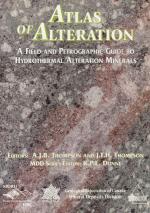Добрый день, Коллеги. Важное сообщение, просьба принять участие. Музей Ферсмана ищет помощь для реставрационных работ в помещении. Подробности по ссылке
Atlas of alteration. A field and petrographic guide to hydrothermal alteration minerals / Атлас изменений. Полевое и петрографическое руководство по минералам гидротермальных изменений
Secondary alteration of rocks and their contained minerals is common in nature. Alteration reflects the interaction of fluid, typically dominated by water, with rock at temperatures that range from warm (< 100°C) to hot (>500°C). For geologists who wish to study the primary mineralogy and chemistry of rocks, alteration is a nuisance to be avoided. Alteration mineralogy, however, documents the post-formation history of the rock, information that has practical implications. In particular, alteration is ubiquitous in and around hydrothermal mineral deposits. The distribution and mineralogy of this alteration relates to the hydrothermal environment, and hence, the type of mineral deposit. More importantly for mineral exploration, hydrothermal alteration around mineral deposits commonly forms halos that provide a target which is much larger than the deposit itself. The mineralogy and in some environments the chemical composition of the alteration provide an indication of the proximity of mineralization, or in the ideal case, a vector towards mineralization. Interpretation of alteration is, therefore, a routine part of exploration for hydrothermal mineral deposits. Similarly, as a product of geothermal activity, the mineralogy of hydrothermal alteration provides information on reservoir and fluid characteristics, and the evolution of the geothermal system. These data are used in conjunction with other information to evaluate potential geothermal resources.
The aim of this book is to provide basic information on hydrothermal alteration, particularly to assist with field and petrographic recognition. It is not intended to be fully comprehensive either in terms of the types of alteration that are covered, or in terms of the processes responsible for alteration. It provides an introduction to the problem through the minerals that are most common, and a general guide to the ore-forming environment. Interpretation in every case is the responsibility of the user, and this book only introduces the
Atlas of Alteration
first step in that process. For students, the information in this book gives an alternative view on the origin of minerals that are commonly encountered in nature. We hope it will help to decipher the 'crud' in thin sections that too often is ignored.




